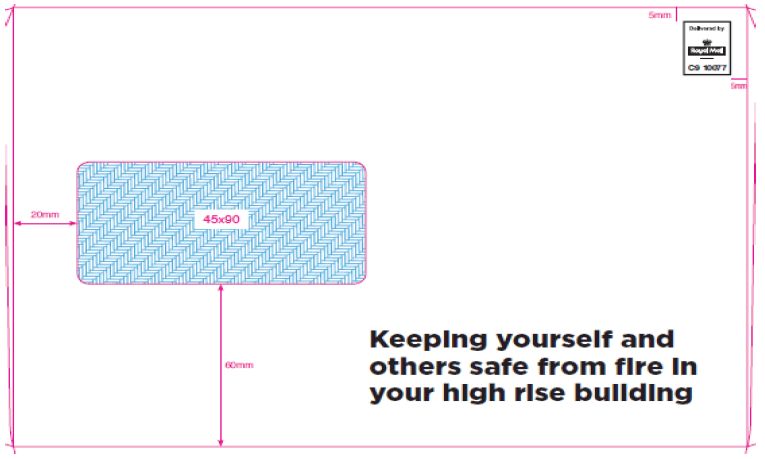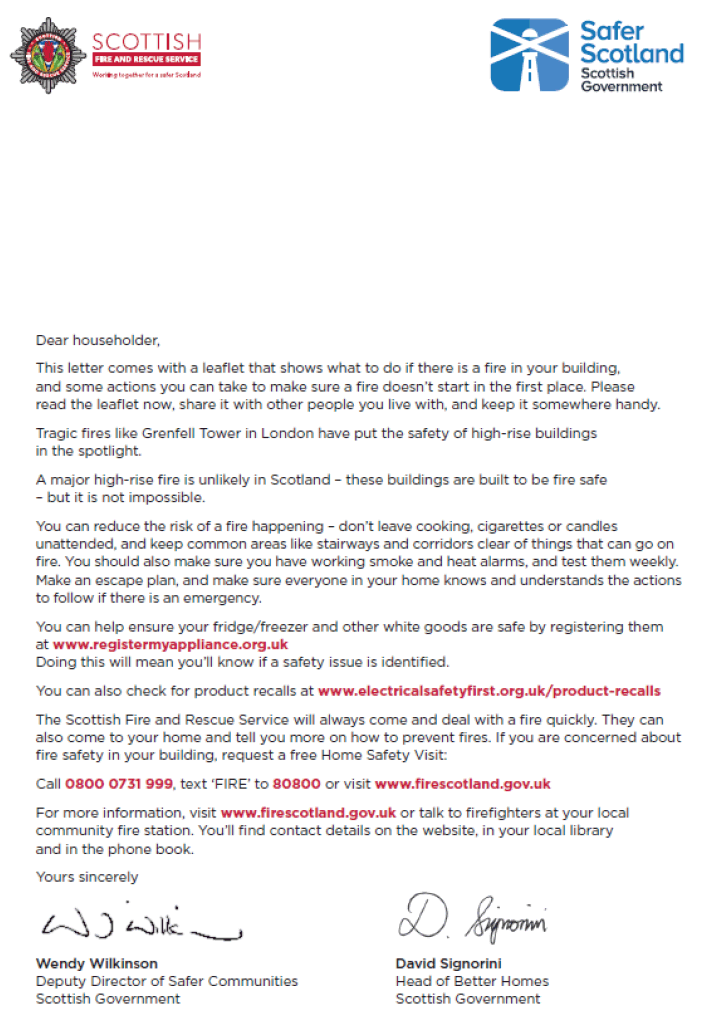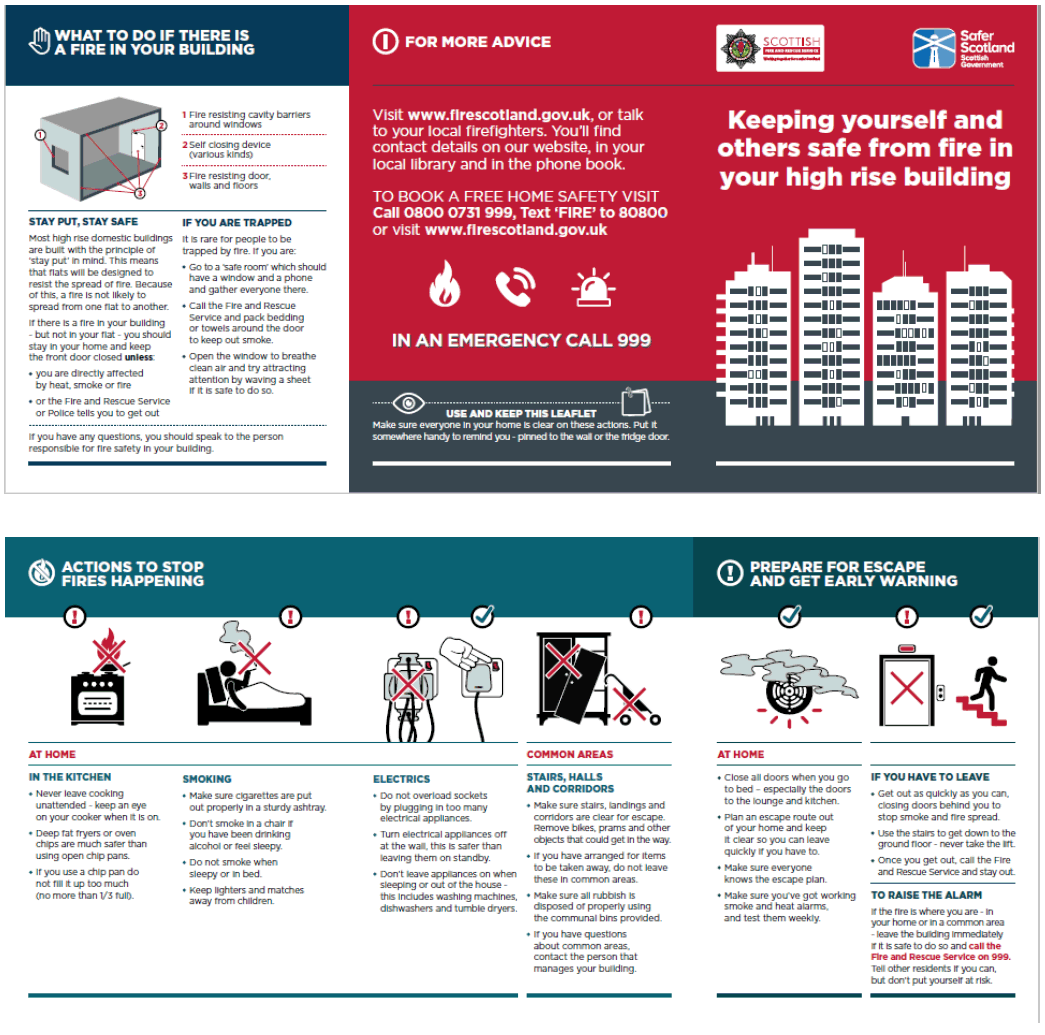High rise fire safety leaflet 2019-2020: evaluation report - July 2020
Results from an exercise to evaluate fire safety guidance leaflets, delivered to all high rise residents, following the Review of Fire Safety Regime in Scotland for High Rise Domestic Buildings.
High Rise Fire Safety Leaflet 2019/20 - Evaluation Report - July 2020
Background
The Scottish Government established the Ministerial Working Group on Building and Fire Safety following the tragic fire at Grenfell Tower in June 2017. This set up a Review of the Fire Safety Regime in Scotland for High Rise Domestic Buildings (The Review) to focus on the fire safety regime and regulatory framework. The Review report can be found here https://www.gov.scot/publications/scottish-fire-safety-regime-final-review/.
One of the recommendations from The Review was to develop and deliver fire safety information to residents of high rise buildings to strengthen knowledge around fire safety in high rise flats, by communicating simple actions that can prevent fires starting and reduce the impact of those fires that do happen in their homes or those of their neighbours.
There was a public consultation and three engagement events and the findings informed the design and delivery of a leaflet on fire safety for distribution to all residents of high rise buildings across Scotland.
The leaflet was sent with a cover letter to all householders in high rise buildings across Scotland. Leaflets were sent to around 44,000 homes in December 2019, and to around 4,000 homes late January/early February 2020.
Leaflet development and delivery
The leaflet was developed to include specific messages around fire safety including:
- Preventative behaviour to stop fires happening in the home and common areas
- What to do if there is a fire in your building
- What to do if there is a fire in your flat
- Where to go for more advice.
On the basis of the above, the following measures can be used for evaluation of this activity:
- Awareness: To generate good levels of awareness of the leaflet
- Engagement: To generate a positive response to the leaflet and good levels of reading of the leaflet
- Knowledge: To increase knowledge of what to do in response to a fire in your building/flat
- Action: To generate claimed action in response to the leaflet.
The leaflet was delivered with a letter, enclosed in a white envelope (as shown below). The letter explained the purpose of the leaflet, encouraged readers to share it with their household and keep it somewhere visible. It also informed householders that they can make sure their fridge/freezer and other white goods are safe by registering them, check for product recalls and visit fire.scotland.gov.uk for more information.
Leaflet Execution



Evaluation
An independent research agency was used to carry out an evaluation of the leaflet. Progressive Research conducted door-step interviews (using CAPI – Computer Assisted Personal Interviewing) from 30 January until 16 February 2020 with residents of high rise buildings in Scotland.
A clustered random sampling method was designed to ensure the sample included a good geographical spread and range of blocks. This guided the selection of local authority areas, types of block within each cluster, households within each block (ensuring coverage of all floors) and individuals within each household. The resulting sample size was 376.
Leaflet performance against the measures described above is summarised below:
Awareness: To generate good levels of awareness of the leaflet
49% were aware (after prompting) of the leaflet, letter or envelope, including 43% aware specifically of the leaflet.
Engagement: To generate a positive response to the leaflet and good levels of reading of the leaflet
Reactions to the leaflet were overwhelmingly positive – at least 8 out of 10 agreed it was clear, useful, relevant and the pictures helped them understand it. Of those who recognised the leaflet, 91% claimed to have read at least some of it.
Knowledge: To generate knowledge of what to do in response to a fire in your building/flat
Those who recognised the leaflet were more likely than those who didn't to agree that they feel well informed about what they can do to reduce the risk of fire in their home (90% vs 79%) and to agree that they feel well informed about what they need to do in the event of a fire (87% vs 75%). Those who recognised the leaflet were more likely than those who didn't to know that if there is a fire in the building but not in your flat the safest thing to do is to stay put if you are not affected by heat/smoke, (54% agreed with this vs 39% of non-recognisers) – suggesting that the leaflet has successfully delivered this message to some.
Action: To generate claimed action in response to the leaflet
Almost three in ten (29%) of those who recognised the leaflet said they had done something as a result of receiving it, and a fifth (20%) mentioned something included in the leaflet. Among those who recognised the leaflet, 27% said 'staying put in their flat' is something they would do differently as a result of the leaflet, in the event of a fire in their building but not in their flat.
Other results to highlight include:
- Prior to prompting with the leaflet, four in ten respondents (40%) said they recalled seeing/hearing any fire safety information in the last 2-3 months. A leaflet through the door was the most common source of this (mentioned by 56% of those who had seen/heard something).
- Almost six in ten (57%) of those who recognised the leaflet said they had kept it, either somewhere visible (30%) or somewhere out of sight (27%). Among those who had read the leaflet, 17% spontaneously said they would refer to this if they wanted further information about fire safety.
- Overall, the vast majority (90%) of respondents could spontaneously think of actions they already take to reduce the risk of fire.
- The most common fire prevention behaviours people claimed they took (at a spontaneous level) were related to:
- smoke/heat alarms (60%);
- electrical appliances (turning off and not overloading) (52%);
- cooking (not leaving attended and cooking chips) (33%);
- smoking (29%).
- On prompting, most people reported they had been taking these actions for a while, suggesting that the leaflet is reinforcing knowledge of these actions.
- However, a minority did claim to have started doing some fire safety behaviours in the last 2-3 months and this was higher amongst people who recognised the leaflet. Among those who recognised the leaflet and felt the behaviour was applicable to them, 10% were not smoking after drinking and 12% when sleepy (although the small bases here must be noted), 10% were not overloading sockets and 6% were turning appliances off at the wall.
- Most respondents spontaneously identified at least one correct action in the event of a fire in their flat – mainly relating to getting out/using stairs (77%).
- Knowledge of what to do in the event of a fire in the building (but not in your flat) was less good. 57% named a correct action and 31% said 'stay put in your flat'.
- However, overall two thirds still don't know they should stay put, and while half agreed that most high rise blocks in Scotland are built to resist the spread of fire, the remainder disagreed (16%) or were unsure (35%).
- In terms of wider context and potential receptivity to fire safety messages, it is interesting to note 85% of those interviewed in high rise buildings said they feel safe from the risk of fire in their home.
Conclusions
- There is clear evidence that the leaflet is standing out and being read and kept as intended by some. However, a further leaflet later this year would be a good reminder, or other communication via other channels may be more useful for providing information to those who didn't recall or engage with the leaflet.
- Reactions to the leaflet were very positive, and this included many respondents agreeing that the pictures were helpful, suggesting that a similar format for future communications would be appropriate.
- While most of the audience know what to do if there is a fire in their flat, many still do not know or actively disagreed that they should 'stay put' if there is a fire in the building but not in their flat, suggesting that further work is needed to increase understanding of and belief in the 'stay put' message.
Contact
Email: Joe.mcshane@gov.scot
There is a problem
Thanks for your feedback